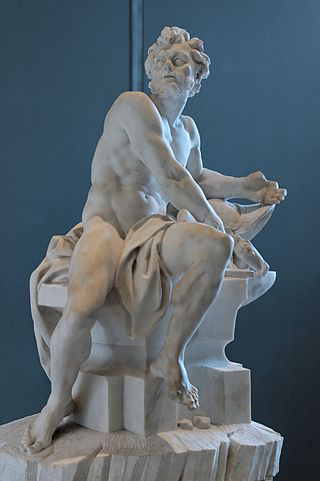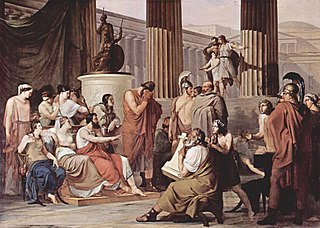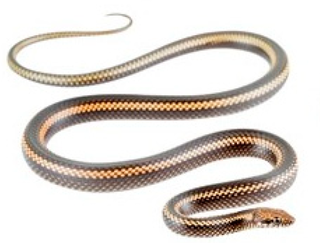
In ancient Greek religion, Hera is the goddess of marriage, women and family, and the protector of women during childbirth. In Greek mythology, she is queen of the twelve Olympians and Mount Olympus, sister and wife of Zeus, and daughter of the Titans Cronus and Rhea. One of her defining characteristics in myth is her jealous and vengeful nature in dealing with any who offend her, especially Zeus' numerous adulterous lovers and illegitimate offspring.

Hephaestus is the Greek god of artisans, blacksmiths, carpenters, craftsmen, fire, metallurgy, metalworking, sculpture and volcanoes. Hephaestus's Roman counterpart is Vulcan. In Greek mythology, Hephaestus was either the son of Zeus and Hera or he was Hera's parthenogenous child. He was cast off Mount Olympus by his mother Hera because of his lameness, the result of a congenital impairment; or in another account, by Zeus for protecting Hera from his advances.

In Greek mythology, Talos — also spelled Talus or Talon — was a giant automaton made of bronze to protect Europa in Crete from pirates and invaders. He circled the island's shores three times daily.

Colubridae is a family of snakes. With 249 genera, it is the largest snake family. The earliest species of the family date back to the Oligocene epoch. Colubrid snakes are found on every continent except Antarctica.

In Greek mythology, King Erichthonius was a legendary early ruler of ancient Athens. According to some myths, he was autochthonous and adopted or raised by the goddess Athena. Early Greek texts do not distinguish between him and Erechtheus, his grandson, but by the fourth century BC, during Classical times, they are distinct figures.

In the Odyssey by Homer, Demodocus is a poet who often visits the court of Alcinous, king of the Phaeacians on the island of Scherie. During Odysseus' stay on Scherie, Demodocus performs three narrative songs.

The Galápagos Islands xeric scrub, also known as the Galápagos Islands scrubland mosaic, is a terrestrial deserts and xeric shrublands ecoregion that covers the Galápagos Islands. The Galápagos Islands are volcanic in origin, and remote from continents and other islands. The ecoregion is well known for its unique endemic species, including giant tortoises, birds, and marine iguanas, which evolved in isolation to adapt to islands' environments.

Franz Steindachner was an Austrian zoologist, ichthyologist, and herpetologist. He published over 200 papers on fishes and over 50 papers on reptiles and amphibians. Steindachner described hundreds of new species of fish and dozens of new amphibians and reptiles. At least seven species of reptile have been named after him.

Xenodontinae is a subfamily of snakes in the family Colubridae.

Alsophis is a genus of snakes in the subfamily Dipsadinae of the family Colubridae. Species in the genus Alsophis are among those snakes commonly called "racers". Alsophis species are endemic to the Lesser Antilles in the Caribbean. One species in the genus Alsophis, A. antiguae, is one of the world's rarest known snakes. Snakes of the genus Alsophis are small and rear-fanged, and they are considered harmless to humans. This genus contains nine described species which are recognized as being valid. Several species once included in this genus have been placed in the genera Borikenophis and Pseudalsophis.

Pseudalsophis is a genus of snakes in the family Colubridae. The genus is endemic to South America. Out of the ten species, nine are endemic to the Galapagos Islands.

The Galápagos racer is a colubrid snake in the genus Pseudalsophis that is endemic to the Galápagos Islands. It is a mildly venomous constrictor but it is not considered aggressive or harmful to humans. The two subspecies are the eastern and western racers, the latter being larger, longer, and darker than the former. The western subspecies specializes in hunting fish, while both subspecies eat small reptiles, eggs, rodents, and bird hatchlings. The Galapagos racer is near threatened due to recently introduced species that feed on snake eggs, including pigs, rats, mice, and cats. It is one of only three species of snakes on the Galápagos Islands, and it was first described in 1860. In November 2016, a video clip from the BBC series Planet Earth II showing a group of Galápagos racers hunting marine iguana hatchlings became a viral trend.
Pseudalsophis thomasi, or Thomas' racer, a species of snake in the family Colubridae. It is endemic to several islands in the Galápagos group.

Scolopendra galapagoensis, also known as the Galápagos centipede and Darwin's goliath centipede, is species of very large centipede in the family Scolopendridae. It is the only representative of the genus Scolopendra on the Galapagos Islands, among twelve other species of centipede present on the Islands. It is also found on mainland South America in Ecuador and Peru, and on Cocos Island in Costa Rica.
Pseudalsophis darwini, otherwise known as Darwin's racer, is a species of snake of the family Colubridae.

Pseudalsophis hoodensis, otherwise known as the Espanola racer, is a species of snake of the family Colubridae.
Pseudalsophis occidentalis otherwise known as the Western Galapagos racer, is a species of snake of the family Colubridae.

Pseudalsophis steindachneri , the Striped Galapagos snake, is a species of snake of the family Colubridae.
Pseudoeryx relictualis , the South American pond snake, is a species of snake of the family Colubridae.















